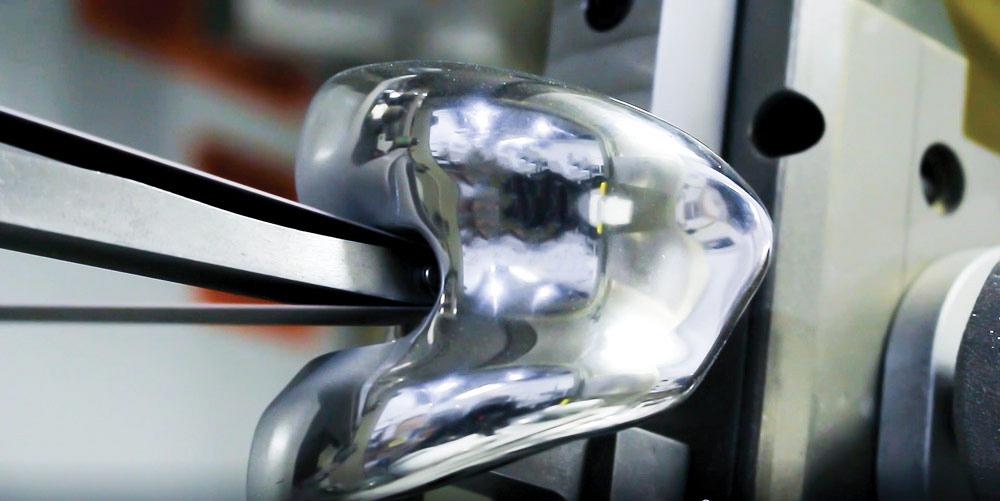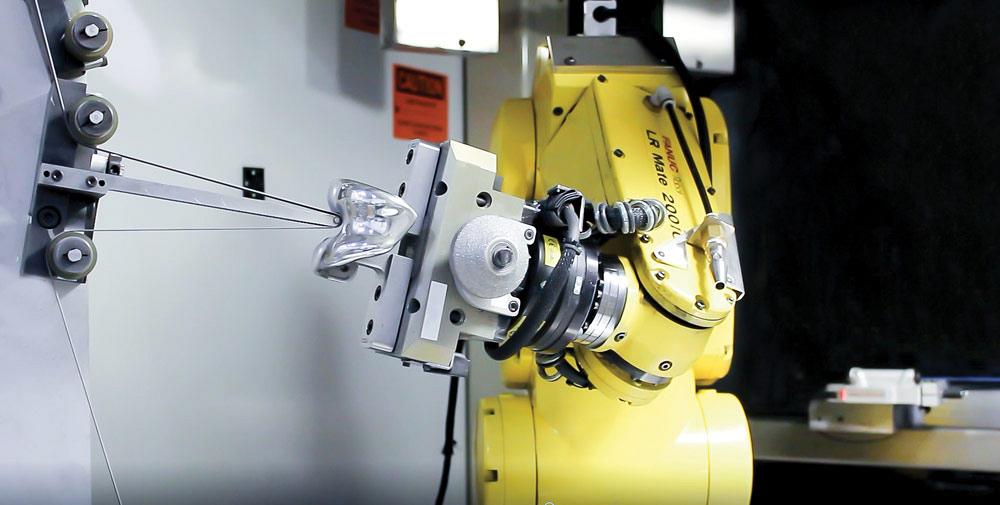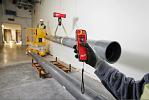Associate Editor
- FMA
- The Fabricator
- FABTECH
- Canadian Metalworking
4 questions on finishing automation
A look at how robotic finishing can be used for medical device manufacturing
- By Lindsay Luminoso
- September 6, 2021
- Article
- Automation and Software

For the most part, mirror finishes are used on medical devices, like this knee implant, to make it easy to identify any defects or blemishes. Images: AV&R
Many industries served by manufacturers are strictly regulated, and the consequences for incorrectly produced components can be catastrophic. The medical device manufacturing sector is one of them. For this industry, achieving a high-quality surface finish is essential to ensure that patients get the best implant or device possible.
The outcome of any orthopaedic replacement surgery depends on the quality of the device that is being placed into the body. Any blemish on the device or implant that shows up in the operating room can lead to numerous potential problems. Not only can it slow down the procedure if the surgeon needs to switch it out with another device, it can also cause serious health issues if a crack or blemish is left undetected and harmful bacteria get in.
For the most part, mirror finishes are used to make it easy to identify any defects or blemishes. Many shops manually polish and finish medical implants. However, finishing automation is becoming more commonplace. Michael Muldoon, sales and product development director, AV&R, Saint-Bruno, Que., explains the benefits of using robotic finishing.
CM: What sort of challenges do medical-grade materials present during the finishing and polishing stages?
Michael Muldoon: Each material has kind of its own idiosyncrasies with the way you finish it. So you want to pay attention to the abrasives and techniques that you are using to get to the final finish.
There are many differences between, say, using titanium versus cobalt chrome when preparing for the finishing and polishing stage. Our focus has been on automating a lot of the hand-finishing processes. So anytime we are grinding or buffing these implants, regardless of the material type, we look for the necessary input condition. The better a manufacturer controls that input condition in the previous steps, the easier it is going to be to automate the finishing operations and get to our surface finishing goal.
For medical-grade materials, one of the most important things to understand is how much heat can be generated before you start creating defects. A common defect, called orange peel effect, leaves a mark on the material because of too much heat.
Different metals react differently to heat. Titanium is particularly sensitive to this, which means we cannot be super aggressive in the finishing stages. This means takt times might be longer than with other materials because you are only able to take off a small amount of material per pass.
Another issue that can be problematic, regardless of the material type, is part distortion. Some robotic systems available can be very aggressive, and for thinner parts or unique shapes, this can put too much heat into the part, causing it to bend. A robotic system should be sensitive to heat issues, and it’s definitely something to consider when automating the process. By ensuring you’re not putting too much heat into the part, you won't have that extra step to correct the deformation that happens. That's an important element that saves a lot of time.
CM: How do input conditions affect finishing operations?
Muldoon: Most medical components are either cast or forged, which means there is usually gate or some flash that needs to be removed. Although these methods have come a long way and they produce fairly good surface conditions, they still require some machining before finishing. The gates and excess material on the parting lines need to be removed and the better job you do of that, the easier the downstream and finishing will be. So during that machining process, a good, dialed-in system can provide very consistent results. That makes finishing much easier.
Since quality is so carefully watched in this industry and each step along the way is regulated, typically there's a measurement or a validation at each point. Did the machine process do what I expected it to do? Did the finishing process turn out as required? In-line inspection is also a big topic when finishing medical devices. If you modify the part, being able to automatically check what you did allows you to move more easily towards automating the process.

A robotic finishing system can be more aggressive than hand finishing, so it can handle taller or rougher machining lines, meaning fewer passes are needed on the CNC.
One of the big benefits of the robotic system is a much more consistent result than what you can achieve by hand. If input conditions vary significantly, then we have to play a lot of tricks. This is where we start looking at adaptive processes and measuring features in different areas. We can adjust the robot path. So the better we are in control of the input conditions, the less of those tricks we have to play when it comes to the robotic system.
CM: How does automated finishing fit in with the overall CNC process?
Muldoon: CNCs are very good at removing large amounts of material and also creating specific shapes because they are rigid machines. With a robot, you can really get the sense of touch, and they are really good at following contours and blending two surfaces together. So they are complementary systems. A CNC machine is making the manufacturer money when it's cutting chips; if it can be doing less work on a part and allow a robot system to do some of the extra tasks, then you're going to get more throughput on your CNC. There's a balancing act that you can do to reap the benefits of putting more work into the robotic system and then allowing your CNC to manufacture more parts, upping the part throughput count.
With hand-finishing operation, it’s important to minimize the machine lines during the machining process so that they are as small as possible. This means the CNC will do more passes. A robotic finishing system can be more aggressive than hand finishing, so it can handle machining lines that are a bit taller and rougher, meaning fewer passes are needed on the CNC.
It is common for designs to build in or include some extra material. This allows an operator to have significant sacrificial material to remove to make it easier to manually blend a part. However, with a robot, finishing is much more controlled, so the design can be optimized to eliminate some of that excess material.
CM: How can shops transition from manual finishing to automated finishing?
Muldoon: The first thing we’d want to know is what sort of abrasives a shop is currently using and what features it is looking to finishing. We need to have a good understanding of the features they need to touch and the target requirements. Is there a surface finish measurement that they require? Is there a dimensional measurement? What makes that a good part when you're done? We also want a good understanding of takt times because that's important.
When you start looking at automation, it's all about getting the best return on investment. Having a good understanding of throughput and takt times is important. In the manual finishing space, when you move to automation, not only will it be more stable, but it may also be able to increase your capacity as a manufacturer. So that's another good benefit.
We recently opened a lab with 3M in Montreal. We believe in validating the process, so customers can send us parts that represent their productions and we'll validate the quality requirements inside of our lab. We'll set it up in a robotic system; do some trials; and make sure that the cycle times, the quality, all parameters are validated. It’s a good way for us to get a handle on input conditions.
Another area of focus for us is making robotic finishing easier to implement. A lot of the smaller shops have multiple part numbers, low-volume manufacturing, and may not think automated finishing is for them. But it certainly can be. The technology should be easy to integrate and adaptable to a high production mix. If you're a smaller shop, it's still worth investigating.
Medical device manufacturers have been adopting robots for a number of years. In this industry, it’s not uncommon to see at least one robot on the shop floor. It’s a tried and true technology. Our message is to continually improve. Don’t settle for what was possible 10 years ago when you first bought the robot. It’s worth looking around and seeing what's out there.
The North American market tends to be more conservative. Many Asian companies are investing a lot of money and time in robotics and additive manufacturing, and we need to be more adaptive to the latest technology in order to compete. Robotic finishing can help shops achieve that high-quality surface finish needed to succeed in the medical device manufacturing sector.
AV&R, avr-global.com
About the Author

Lindsay Luminoso
1154 Warden Avenue
Toronto, M1R 0A1 Canada
Lindsay Luminoso, associate editor, contributes to both Canadian Metalworking and Canadian Fabricating & Welding. She worked as an associate editor/web editor, at Canadian Metalworking from 2014-2016 and was most recently an associate editor at Design Engineering.
Luminoso has a bachelor of arts from Carleton University, a bachelor of education from Ottawa University, and a graduate certificate in book, magazine, and digital publishing from Centennial College.
subscribe now


Keep up to date with the latest news, events, and technology for all things metal from our pair of monthly magazines written specifically for Canadian manufacturers!
Start Your Free Subscription- Industry Events
ZEISS Quality Innovation Days 2024
- April 15 - 19, 2024
Tube 2024
- April 15 - 19, 2024
- Düsseldorf, Germany
CTMA Economic Uncertainty: Helping You Navigate Windsor Seminar
- April 30, 2024
- Windsor, ON Canada
MME Winnipeg
- April 30, 2024
- Winnipeg, ON Canada
CTMA Economic Uncertainty: Helping You Navigate Kitchener Seminar
- May 2, 2024
- Kitchener, ON Canada




















